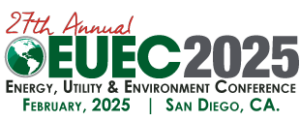ASH PONDS, LINERS, REMEDIATION, WATER, WWM, ELG, FGD, 316(b), O&M
Room 4 Track I – Thursday, February 15, 2024
This Track provides presentations on current technologies and strategies, concerning water and wastewater management, including 316 (b), cooling towers, FGD, ZLD, coal ash, and remediation in the energy industry.
I1
CCR | Impoundments | ZLD | LSA | Remediation
Feb 15 ( 7:30 – 9:30 am)


Bottom Ash Transport Water Chemistry in High Recycle Rate Systems
Bottom Ash Transport Water Chemistry in High Recycle Rate Systems
Bottom Ash Transport Water Chemistry in High Recycle Rate Systems
David Donkin – UCC Environmental
The coal-fired electrical utility sector is faced with the regulatory requirement to retire their coal ash sluicing ponds under the finalized Coal Combustion Residuals (CCR) regulation in the Spring of 2021. Wet-to-dry ash handling solutions are being implemented throughout the fleet to allow ponds to come out of service. However, the final disposition of outage wash wastewater, specifically the wastewater generated from washing boiler internals, air pre-heater, economizer and precipitator systems must also be considered. Historically these washwaters were simply directed to the CCR pond along with other ash materials and treated by dilution and settling prior to discharge. This option is longer available. The primary constituents of concern are total suspended solids, iron, copper and other heavy metals, and pH control. In addition, outage wash wastewater presents unique challenges with respect to wide flow variations and contaminant loading changes throughout a wash. A temporary or permanent retro-fit of existing wet-to-dry bottom ash handling systems can allow these systems to serve as a wastewater treatment system in order to meet water quality requirements with respect to outage wash wastewater streams. UCC Environmental’s lessons learned from over 2 years providing these retrofits and treating wastewater from outage washes will be reviewed.


Zero Liquid Discharge an Integrated Solution for the Power Industry
Zero Liquid Discharge an Integrated Solution for the Power Industry
Scott Holder – Alfa Laval
Typical Zero Liquid Discharge (ZLD) applications are seen as a solution for a specific problem resulting in projects being siloed as traditional wastewater treatment systems. This approach prevents the full impact and utilization of ZLD within the power industry. ZLD systems can utilize process or waste heat to drive evaporation, reclaim water, reduce waste, and reduce the consumption of resources such as water. Ultimately, this approach can have the greatest effect on a facilities environmental impact and risk. Zero Liquid Discharge systems are a combination of technologies that work together to minimize wastewater as much as technically and economically practical, often resulting in a concentrated solid product and high-quality clean water for re-use or environmental discharge. Integrating a ZLD system into your process increases resiliency by reducing both cost and risk. Zero Liqui Discharge works to secure control over your water source and waste disposal reducing the influence of factors outside of your control. In many applications, ZLD should be seen as a comprehensive solution utilizing all aspects of the power generator process. Waste energy can be used to concentrate waste stream and recover water for reuse within the facility.Water scarcity, new Fuel-gas desulfurization (FGD) regulations, and a circular economy are driving industries to rethink their business models from the ground up. Zero Liquid Discharge should be seen as an integrated solution for beneficial reuse of both water and energy within the power energy Maximization of energy utilization through capturing high-temperature waste heat normally discarded to the cooling towers is one example of how this can be achieved.


A Comparative Life Cycle Assessment of Corrective Action Alternatives to Evaluate Sustainable Remediation
A Comparative Life Cycle Assessment of Corrective Action Alternatives to Evaluate Sustainable Remediation
Matthew Biega – Gradient Corp
Life cycle assessments (LCAs) empower stakeholders to understand environmental impacts and allow for informed decision-making regarding sustainable alternatives. One LCA application that supports the comparison of environmental impacts is the selection of remedial corrective actions. This study reviewed a comprehensive LCA performed to assess the environmental sustainability of corrective action alternatives for groundwater remediation at an example industrial site. Three corrective action alternatives were considered: monitored natural attenuation (MNA), pump and treat (P&T), and permeable reactive barriers (PRBs). As part of this LCA, a variety of environmental impact categories were evaluated, including global warming, acidification, eutrophication, ozone depletion, smog, respiratory effects, human health, and ecotoxicity. The findings of the comparative LCA revealed substantial differences in the environmental impacts associated with MNA, P&T, and the PRB when each of the methods were applied to the example site. MNA was found to have the lowest overall environmental impacts, followed by P&T, while the PRB had the highest impacts. Operational energy of the pumping system was determined to be the major impact driver in the P&T scenario, while the potential impacts of the PRB were shown to be driven by the reactive medium supply.


The Basics of Deep Well Injection as a Leachate Disposal Option
The basics of Deep Well Injection as a Leachate Disposal Option
Monte Markley – SCS Engineers
I2
EPA 316 (b) | Leachate Disposal | PFAS | Silica |
Feb 15 (10 am – 12 pm)

PFAS Destruction in High Strength Waste Streams: A Case Study on Low Energy EOx
PFAS Destruction in High Strength Waste Streams: A Case Study on Low Energy EOx
PFAS Destruction in High Strength Waste Streams: A Case Study on Low Energy EOx
Elisabeth Christ – Aclarity
With recent action by the USEPA and individual states, stricter regulation of poly- and perfluorinated alkyl substances (PFAS) in water and solids wastes will change the way that the water industry has dealt with organic contaminants in the past. Typically, regulated organic contaminants have been controlled through the use of oxidation, e.g., ozonation or chlorination, or by adsorption onto activated carbon, followed by high temperature regeneration. Because of the chemical and thermal stability of PFAS compounds, however, these approaches will not work. It has been shown that even the strongest oxidant commonly used in water treatment, hydroxyl radicals, cannot degrade these compounds. It has also been shown that some PFAS is not destroyed by thermal regeneration of activated carbon, even with an afterburner. Several states have banned the incineration of PFAS-containing wastes.These circumstances have led the industry to search for technologies capable of destroying PFAS by breaking carbon-fluorine bonds, among the strongest known in organic chemistry. Among these destructive technologies are supercritical water oxidation (SCWO), hydrothermal alkaline treatment (HALT), plasma reactors, and electrochemical oxidation (EOx).To date, these technologies have been studied at relatively small scales, and are not economic for treating the millions of gallons per day flows for water treatment plants. However, when coupled with concentration technologies such as high pressure membranes, regenerable ion exchange, or foam fractionation, the technologies can be viable for use in municipal water treatment.This presentation will show results from bench and pilot scale testing of Aclarity’s EOx system treating multiple high strength wastes including reverse osmosis brine, raw landfill leachate, ion exchange brines and foam fractionate. In addition to PFAS destruction data, transformation byproducts will be addressed. Economic data demonstrating viability at larger scales will also be presented.


EPA 316b Impact on Circulating Water Pumps and Motors
EPA 316b Impact on Circulating Water Pumps and Motors
Kurt Schumann – President, ProPump Services


Advanced Solidifiers for Oil Spill Containment
Advanced Solidifiers for Oil Spill Containment
Evgeniya Hristova – Natural Resources Canada


Solutions for Online Silica Monitoring in Power Plants and Ultrapure Water Facilities
Solutions for online silica monitoring in Power Plants and Ultrapure Water Facilities
Andrew Xie – Thermo Fisher Scientific
Silica in boiler feedwater and steam could cause silica deposition on power plant turbines and heat exchange tubes, which leads to inefficiencies, equipment failure and increased maintenance. Monitoring soluble reactive silica at ppb level in ultrapure water with an online analyzer allow users to detect excess silica and enable water treatment operations to remove silica through prior to boiler and turbine. Online Silica analyzers are widely used for monitoring boiler feedwater and ultrapure water in various industries, such as power plants, oil refineries, and manufacturing plants. Especially, Peaker power plants, which turns on and off regularly on demand, poses significant challenges to online silica analysis due to their intermittent flow, particles in sample, analysis and reagent stability requirements.Thermo Fisher Scientific developed the Orion 8030cX Silica Analyzer to solve silica monitoring challenges to prevent silica built-up, improve energy efficiency and maximize uptime. It offers superior accuracy, reliable operation, automated features and intuitive user interface to protect valuable assets and ensure safe power generation. It combines a patented fluid delivery system with smart flow sensing and auto-cleaning to resolve challenges related to intermittent flow and particles in sample. The optimized reagent chemistry minimizes common interferences from phosphate and lasts longer. Consuming only about 200 µL of reagent per test, the new analyzer can continuously monitor unattended for up to 100 days while reducing chemical waste. The 8030cX Silica Analyzer features state-of-the-art automation (such as automated calibration, validation and cleaning), advanced intuitive software, intelligent system diagnostics and alert notifications that reduce manual intervention and maintenance.

